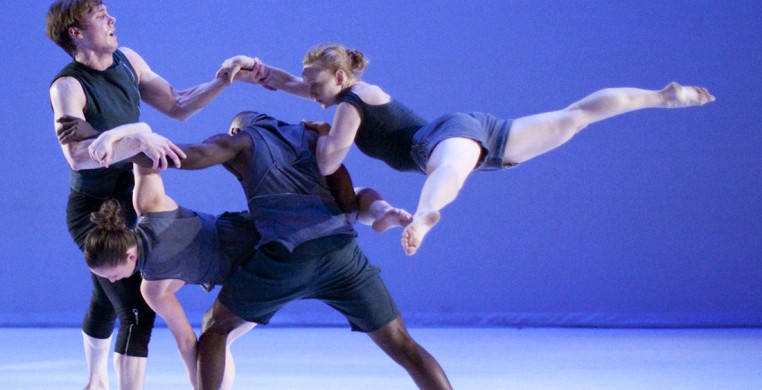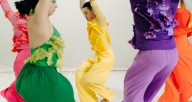You would certainly not hesitate to call The Seldoms a dance company, but it has carved a unique identity for its bold use of dance to dive headlong into global issues that typically transcend dance and go well beyond the range of conventional choreographic exploits. Often intertwining choreographed passages with spoken text, theater, video, and original live music, recent works have addressed the 2008 recession, power and powerlessness in America, and the social phenomenon of “The Sixties.”
“Marchland,” (continuing a two-weekend run at Links Hall, 7 PM, June 28-30) looks at physical and psychological boundaries, and the impact of building, breaking, and redefining walls and barriers on bodies in motion. In The Seldoms' reprise of choreographer and artistic director Carrie Hanson’s 2010 work, which premiered at the Museum of Contemporary Art, “Marchland” is more squarely anchored in dance and choreographic construct than some of Hanson’s more recent works. Its implication for interpersonal and geopolitical relationships is inescapable.
The current iteration reconfigures from the original eight dancers to a tight ensemble of two men and four women. The piece moves gracefully into Links Hall’s airy blackbox space, with the audience seated above and around three sides of a thrust performance space. A raised stage occupies the upstage corridor where musicians Timothy Daisy and Phillip Sudderberg hold prominent focus behind two trap sets and a host of percussion instruments.
Their musical partnership with the dancers and the dance is more an auditory aspect of the overall concept than accompaniment, issuing its own form of building and breaking barriers with clashing rhythms, antagonistic interplay, driving pulse and suspenseful sound effects. Sometimes imitative of the movement, sometimes triggering movement explosions, the tom-toms, snare drums, cymbals, xylophone and rustling sticks also illuminate the silent light spectacle of Fraser Taylor’s animation, projected onto the white flooring.
“Marchland,” which refers to border regions, the threshold between two places, is where the action ignites. Underscoring the sense of physical boundaries, the piece begins with the projection of a dark rectangle unfolding along the floor like a carpet from the audience end of center stage to the raised upstage platform, bisecting the space. From the beginning, it is a dangerous, volatile landscape where no one can count on the floor beneath their feet, and a competitive mistrust colors collaboration. It’s all about deal-making and equivalencies: what do I give for what I get?
Two dancers appear, a man and a woman. They negotiate their physical boundaries and the space between them with a thrust arm or leg slicing across each other’s body to arrest an intended move. They eye each other cautiously, wrap arms around each other, rewrap, detach, renegotiate and leverage their bodies against each other like bargaining chips. They run from each other, then run in place together. Gradually other bodies enter the space, replacing partners, wrapping arms around new bodies, creating permutations of buddies and adversaries until all six dancers are in the space.
The sound of vibrating sticks corresponds to a video projection of vibrating patterns moving along the floor and over the forms of the dancers. A sudden congealing of energies unites all six in a brief interlude of unison movement. A recurring motif emerges: one arm thrust straight to the side, hand fluttering like a sensory premonition of danger.
There is a neutrality to the inventive muscular interactions, lifts, counter-balances and group configurations, no overlay of emotion, and yet we intuit tension, mistrust, wariness from Hanson’s deft configuration of sound, image, and movement.
At one point the dancers form a chain linked by clasped hands, pulling in and out of tension as they leverage their weight across their hand-holds.
The movement is large and bold, linear and beautiful to watch for the ever-changing visual picture in this hour-long, uninterrupted slice of life-goes-on. The dancers, each of them distinctly individual, each in his or her own version of Lara Miller’s zippered gray-toned skirt, slack, or shorts and drapey T’s, brought singular clarity and definition to movement invention that took your eye and held interest with exciting spatial design.
I never tired of watching the various segments of solo, duet, and ensemble passages, but the main idea of separation and congealing, wall building and breaking in one form or another, reiterated itself continuously in a mostly steady-state of high energy that became somewhat predictable. Several refreshing unison interludes offered the contrasting dynamic of momentary solidarity, accentuated by audible group breathing, which quickly splintered into divisive coupling and de-coupling.
An acceleration and intensification of wild drumming, even wilder video projections, and wild running, built to a climax, leaving a single woman running by herself, a final audible breath drawing to blackout. In the end, "Marchland" seemed to lament, we are each of us an island in space.


